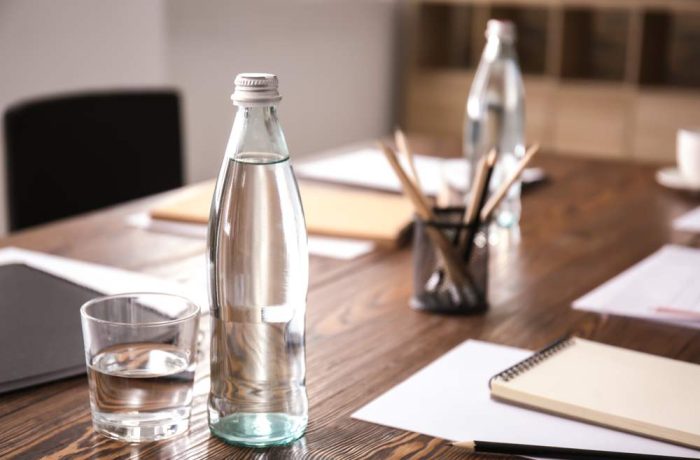
Next time you go to the store, skip the aisle with all the plastic water bottles. While they might be advertised as recyclable and the price can be enticing, spending money on plastic water bottles can negatively impact the environment in a big way. Disposable plastic water bottles often end up in the garbage and carted off to landfills, or they get discarded in lakes, rivers, and oceans, where they harm natural wildlife and resources. Plastic bottles can even contain harmful pollutants and chemicals like BPA that cause health issues. Glass water bottles, on the other hand, offer a wide array of advantages over their plastic counterpart. Plus, you will never have to worry about that funky plastic aftertaste when drinking water from a glass bottle. When you switch to a glass water bottle, you do your part to positively impact the environment.
Environmental Impact of Plastic Water Bottles
You might be surprised to learn just how much of a negative impact plastic water bottles have on our environment. The entire life cycle of the disposable plastic water bottle drains natural resources. Not everyone chooses to recycle their plastic water bottles, either, and much of these end up in landfills or littering land and bodies of water. Plus, while plastic often gets advertised as a recyclable product, only certain types of plastic are commonly accepted at recycling centers in the US. Here are three ways plastic water bottles negatively impact the environment.
Uses fossil fuels
Millions of barrels of oil are used to manufacture plastic water bottles. Many plastic parts are also made from fossil fuels and are products of the oil and gas industries. Plastic processing facilities make everything from soft drinks to packaging, and the demand for plastic products is always high. This leads to a lot of creation of plastic that also needs to be transported all across the world, which ends up using even more fossil fuels for transportation.
Contributes to global warming
While making plastic water bottles, tons of carbon dioxide gets released into the air. An increase of carbon dioxide in the air causes what is known as the greenhouse effect, which increases the earth’s overall temperature. Plastic water bottle manufacturing and transportation contribute to global warming, which will lead to dangerous weather events and harm our communities.
Causes pollution
Plastic waste litters the shores of lakes, rivers, and oceans all across the globe. In fact, plastic pollution has become a major environmental issue. Especially in areas with lower recycling rates, plastic ends up in landfills or as litter. Despite some people’s best efforts to recycle at home or in the office, plastic waste still builds up and causes pollution. As plastic breaks down over time, it also leaches out harmful chemicals into soil and water, which can harm wildlife and end up back in our drinking water and food sources.
Environmental Impact of Glass Water Bottles
Glass water bottles offer an eco-friendly choice for people who want to lessen their environmental impact. When you use a glass water bottle, you can refill it as many times as you need because, unlike plastics, glass does not lose quality or integrity over time. When trying to reach your goal of drinking a certain amount of water each day, grab a reusable glass water bottle to keep your water fresh. Here are ways glass bottles have less of a negative impact on the environment than plastics.
Endlessly recyclable
Glass is endlessly recyclable, which means you can recycle glass over and over again without it losing its strength or quality. This means manufacturers spend less time creating new supplies of glass water bottles and other glass products because they can recycle glass for a fraction of the cost and with minimal environmental damage. Recycling glass helps reduce emissions and save energy. Glass gets crushed, blended, and melted together to recreate new products that work just as effectively. It takes less energy to create a glass water bottle from recycled glass than it does to melt raw materials to make new glass. The reusable design of glass water bottles and other glass products allows for a more positive impact on the environment. When glass goes through the recycling process, it does not need harsh chemicals to treat it or enhance its durability. The recycling process for glass can go on forever because, as a raw material, glass never wears out.
Reduces space in landfills
When you invest in a reusable glass water bottle, you cut down on the amount of plastic waste that ends up in landfills. Even plastic bottles advertised as reusable will slowly break down over time. As this happens, you might end up tossing it in the garbage, or the type of plastics it’s made of ends up not being recyclable. The less we rely on single-use plastics, the less waste takes up landfill space. You can refill a reusable glass water bottle countless times. Think of how many plastic bottles you will keep from going to waste when you have a glass bottle that does not wear down with age. Glass water bottles also do not require any extra packaging like plastic water bottles do. Plus, your glass water bottle will take up so much less space in your own home than a case of plastic bottles. When you don’t buy as much stuff, like cases of plastic water bottles for single-use, the less stuff that ends up in your garbage and filling up your local landfill.
Reduce, Reuse, Recycle!
We all learned about the three Rs in elementary school: “reduce, reuse, recycle.” What you may not have learned is that the order actually matters! When you focus on reducing your waste first, you cut back on the overall amount of trash that ends up in landfills. Focus on reducing the amount of non-recyclable and non-reusable products to help decrease the amount of garbage on the earth. Then consider what items would work best for reuse. So many plastic products have recyclable alternatives that can be reused over and over again, like plastic vs. glass water bottles. You can find new uses for old items, from furniture to clothing. Lastly, when you have reduced the amount of waste you produce and determined what in your life can be reused, you can then focus on investing in recyclables and turning something old into something new again.
Why Water Tastes Better in a Glass Water Bottle
Last but certainly not least, water just tastes better in glass water bottles! Glass bottles are free from contaminants that can negatively affect the flavor in your water. Nobody wants to drink water that has a plastic or metal taste to it. Glass water bottles preserve the freshness of your water, and you can always expect the same pure taste. Glass water bottles are also easy to clean, which makes them a great option for reuse. When you run a glass bottle under hot water or through the dishwasher, you don’t have to worry about it breaking down, melting, or degrading over time. Experience the Lipsey Water difference when you invest in your own reusable glass water bottles and know that you are making a difference for your health and your environment.
